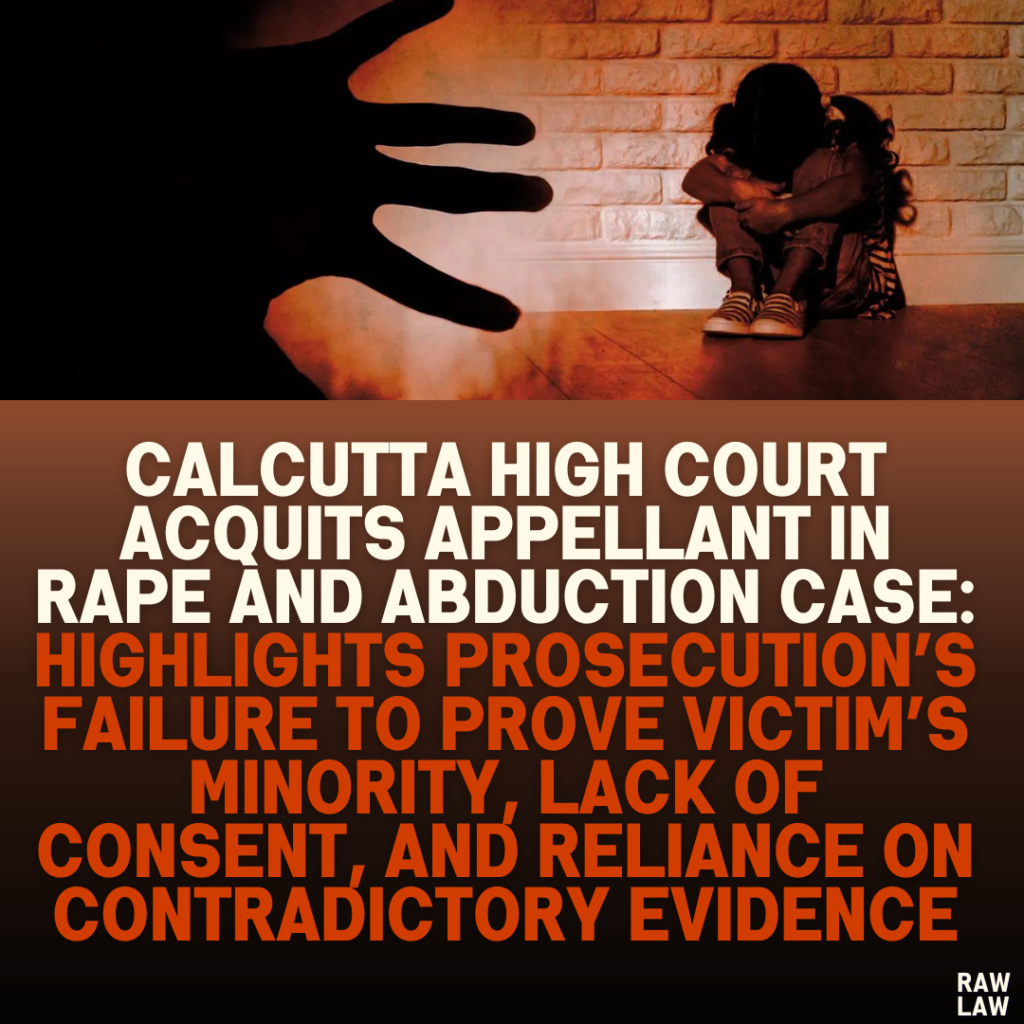Court’s Decision:
The Calcutta High Court allowed the appeal and set aside the conviction and sentence passed by the trial court. The trial court had earlier convicted the appellant under Sections 366 (kidnapping or abduction with intent to compel marriage) and 376 (rape) of the Indian Penal Code, sentencing him to rigorous imprisonment. The High Court found that the prosecution had failed to substantiate its claims with credible evidence and acquitted the appellant.
Facts of the Case:
- The appellant was accused of abducting a minor girl (PW 7) under the pretext of marriage, attempting to sell her to a brothel, and committing rape.
- The victim’s father (PW 1) lodged a complaint after the victim went missing, alleging that the appellant had forcibly taken her.
- The police rescued the victim, and she later alleged in her statement before a magistrate that she was abducted and raped.
- During the trial, the victim testified that she had voluntarily accompanied the appellant and stayed with him for three months. She claimed that her magisterial statement was made under her father’s pressure.
Issues:
- Was the victim a minor at the time of the alleged incident, thereby negating her ability to give valid consent?
- Did the appellant forcibly abduct and rape the victim, or was the act consensual?
Petitioner’s (Appellant’s) Arguments:
- The appellant contended that the victim voluntarily accompanied him and stayed at her sister’s residence for three months without coercion.
- It was argued that the victim’s magisterial statement was inconsistent with her deposition in court and could not be relied upon as substantive evidence.
- The prosecution failed to produce school records or any other conclusive evidence to prove the victim’s minority.
- No DNA evidence was presented to establish that the appellant was the father of the victim’s foetus.
Respondent’s (State’s) Arguments:
- The State argued that the victim was a minor, as recorded in her magisterial statement, where her age was stated as 14.
- It was submitted that the victim’s pregnancy was evidence of rape, and her consent (if any) was immaterial because she was a minor.
- The State contended that the trial court correctly relied on the victim’s magisterial statement to convict the appellant.
Analysis of the Law:
- Admissibility of Statements Under Section 164 CrPC:
- The court emphasized that statements recorded before a magistrate under Section 164 of the Code of Criminal Procedure are not substantive evidence. They can only be used to corroborate or contradict the testimony of the witness in court. Since the victim contradicted her magisterial statement during her deposition, the trial court erred in relying solely on it.
- Burden of Proof for Minority:
- The prosecution was required to prove the victim’s age to establish her minority. Although the victim’s magisterial statement and her father’s testimony mentioned her as a school-going girl, no school records or official documents were presented to substantiate her age.
- Importance of DNA Testing:
- Under Sections 53A and 164A of the CrPC, DNA testing is crucial in cases of alleged rape to confirm the identity of the perpetrator. No DNA test was conducted on the foetus to establish whether the appellant was its father.
- Voluntary Nature of the Act:
- The victim consistently testified in court that she voluntarily stayed with the appellant and was not coerced. Her testimony outweighed her earlier magisterial statement, which she claimed was made under pressure from her father.
Precedent Analysis:
The judgment highlighted established legal principles:
- Statements under Section 164 CrPC require corroboration.
- The burden of proving essential facts, such as the victim’s minority or lack of consent, lies with the prosecution.
- Convictions must be based on substantive and reliable evidence, not assumptions or inconsistent testimonies.
Court’s Reasoning:
- The victim’s testimony in court was clear and consistent that she went with the appellant voluntarily. She also clarified that her magisterial statement was made under her father’s instructions.
- No corroborative evidence, such as school records or DNA tests, was provided to support the prosecution’s claim of the victim’s minority or lack of consent.
- The court observed that the trial court relied heavily on the magisterial statement without properly evaluating the contradictions in the victim’s testimonies.
Conclusion:
The High Court held that the prosecution failed to:
- Prove the victim’s minority beyond reasonable doubt.
- Establish that the sexual act was non-consensual.
- Provide corroborative evidence of the allegations of abduction or coercion.
The appellant was acquitted, and his conviction and sentence were set aside.
Implications:
This judgment underscores critical legal principles:
- Reliance on Evidence: Convictions must be based on reliable and substantive evidence. Inconsistencies or gaps in evidence can lead to acquittals.
- Importance of Procedural Safeguards: Proper documentation (e.g., school records, DNA tests) is vital for proving essential elements like age and paternity in criminal cases.
- Protection of Rights of the Accused: The judgment reinforces the principle that doubt benefits the accused, ensuring a fair trial.




Pingback: Calcutta High Court Dismisses Revision Petition Under Article 227: Declares Dismissal of Suit by Trial Court as a Decree and Affirms Appeal as the Proper Remedy Under Section 115 CPC - Raw Law